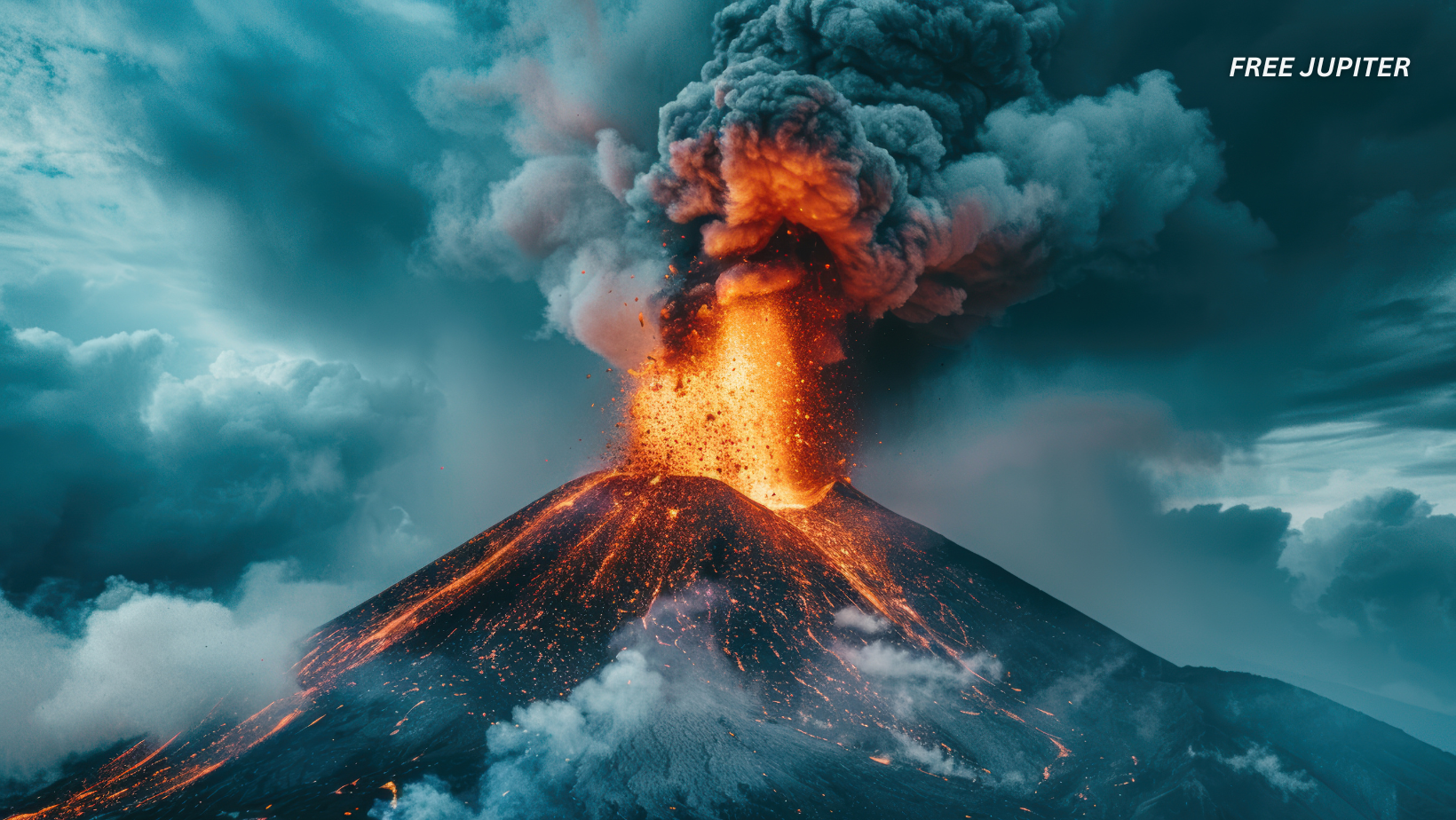Scientists remain on high alert after identifying a significant indication that a volcano in the United States may be nearing an eruption.
Large steam plumes have been observed rising from Mount Spurr, one of Alaska’s most active volcanoes. Although the volcano last erupted in 1992, signs of increased activity have persisted for months. The Alaska Volcano Observatory (AVO) has now assessed that an eruption in the near future is a strong possibility.
Experts monitoring Mount Spurr believe that an explosive eruption could occur within as little as three weeks. The volcano, situated approximately 80 miles (128 km) from Anchorage, reaches an elevation of 3,374 meters (11,070 feet), making it the highest volcano in the Aleutian mountain range.
Recent Observations and Findings
On March 26, a particularly robust plume of steam was detected rising from the summit. While the sudden appearance of the plume can be attributed to favorable weather conditions, scientists have pointed to other indicators that suggest an eruption may be imminent.
In an official statement, the AVO noted that increased gas emissions confirm the intrusion of new magma into the Earth’s crust beneath the volcano. This indicates that an eruption is likely, though not guaranteed, to take place within the coming weeks or months.
Structure of Mount Spurr
Mount Spurr comprises a central summit and a major side vent, Crater Peak, located approximately two miles (3.5 km) to the south. All major historical eruptions have originated from this vent. Over recent weeks, both scientists and local observers have reported a significant volcanic plume rising from the summit. However, while the presence of steam confirms activity, experts caution that it alone does not necessarily indicate an increased risk of eruption.
Read more: Scientists Say Eruption at Alaska’s Mount Spurr is Likely, And Preparations Should Begin
Atmospheric Conditions and Steam Formation
According to the AVO, the plume’s visibility is likely influenced by atmospheric conditions such as low wind speeds and cool, wet weather, which promote the formation of steam. On March 26, when the plume appeared most pronounced, these weather conditions were optimal for such a formation.
Further analysis of satellite remote sensing and geophysical data from March 26 did not reveal any significant changes in volcanic activity. Given this, scientists believe that the recent steam plume resulted from environmental factors rather than an increase in volcanic activity. However, while the steam itself may not be an immediate warning sign, additional evidence points toward a potential eruption.
Increased Gas Emissions and Seismic Activity
During flyovers conducted on March 7 and 11, aircraft collected gas samples from the summit and Crater Peak. The findings revealed that Mount Spurr is currently emitting approximately 450 tons of sulfur dioxide per day—nine times the amount recorded in December 2024, when emissions were below 50 tons daily. Additionally, carbon dioxide concentrations above Crater Peak have reached particularly high levels, a pattern previously observed prior to past eruptions.
Seismic activity beneath the volcano has also increased. Currently, over 100 earthquakes occur weekly in the region, suggesting that magma is accumulating within a subterranean magma chamber. Since April 2024, approximately 3,400 earthquakes have been recorded beneath Mount Spurr, further indicating escalating volcanic unrest.
Moreover, steam is now emanating from new locations around the summit and Crater Peak, many of which have remained inactive since 2008. This development raises additional concerns among researchers closely monitoring the volcano.
Likelihood of an Explosive Eruption
An explosive eruption remains the most probable outcome of these increasing warning signs. In 1992, a major eruption followed only three weeks after similar activity was detected. Nonetheless, the AVO warns that an eruption could occur with little or no additional notice.
Since October 2024, Mount Spurr has been designated under a yellow/advisory warning status. Should the activity continue to escalate, the AVO may elevate the alert level to orange/watch or even red/warning.
Read more: Scientists Reveal Where Yellowstone’s Next Big Eruption Is Most Likely to Happen
Potential Hazards of an Eruption
If an eruption takes place, it is expected to resemble the significant events recorded in 1992 and 1953. The most concerning hazard in such a scenario would be the release of airborne ash clouds, propelled high into the atmosphere by the eruption’s force.
The most recent eruption sent an ash column soaring 12 miles (20 km) above sea level, leading to widespread disruptions. Airports, offices, and schools were forced to close, and cleanup efforts cost nearly $2 million (£1.54 million).
Inhaling volcanic ash poses health risks, particularly to the respiratory system. Residents of Alaska have been advised to wear protective masks or stay indoors should an eruption occur. Other potential hazards, such as pyroclastic flows and mudflows (lahars), would be more localized and unlikely to pose a serious threat to nearby communities.
How Scientists Predict Volcanic Eruptions
Challenges in Prediction
Eric Dunham, an associate professor at Stanford University’s School of Earth, Energy, and Environmental Sciences, explains that volcanic activity is highly complex. Currently, no universal method exists for accurately predicting eruptions, and it is unlikely that one will ever be developed. However, researchers have identified several key indicators of volcanic activity that help estimate the likelihood of an eruption. These include:
Volcanic Infrasound: When magma rises in the crater of an open-vent volcano, the pitch or frequency of sounds generated by the movement of magma tends to increase, signaling a potential eruption. Special infrasound monitoring stations are used to detect and analyze these low-frequency sound waves, which provide insight into magma movement and changes within the volcano.
Seismic Activity: Small earthquakes and tremors often intensify before an eruption, as magma forces its way through underground chambers. By monitoring patterns in earthquake swarms, scientists can assess the likelihood of an eruption. Instruments such as seismometers help measure and analyze these seismic events, allowing researchers to identify potential eruption timelines.
Read more: Earth’s Core Is Leaking, And Scientists Have Finally Figured Out Why
Gas Emissions: As magma approaches the surface and pressure decreases, gases such as sulfur dioxide, carbon dioxide, and hydrogen sulfide escape. Increased emissions of these volcanic gases indicate that magma is rising within the volcano. Continuous gas monitoring using spectrometers and direct sampling methods provides critical data on changes in gas levels and eruption forecasting.
Ground Deformation: Changes in the shape of a volcano—such as swelling, sinking, or cracking—suggest that magma, gases, or fluids are shifting underground. Satellite-based radar technology and GPS sensors are used to track subtle deformations in the volcano’s surface. Swelling of the ground may indicate that magma is accumulating beneath the surface, increasing the likelihood of an eruption.
Thermal Anomalies: Heat signatures detected on the surface of a volcano can indicate rising magma. Infrared satellite imagery and thermal cameras are used to detect temperature changes that may signify increasing volcanic activity.
By closely monitoring these factors, researchers aim to improve eruption forecasting and provide timely warnings to those living in affected areas. However, given the unpredictable nature of volcanoes, authorities urge continued vigilance and preparedness. The combination of seismic data, gas emissions, ground deformation, and thermal imaging offers the best chance at anticipating eruptions and mitigating their impact on communities.










